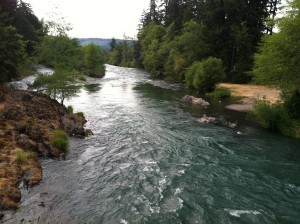 I have worn a few different hats while studying, working, and now serving under the umbrella of the Community Service Center (CSC) at the University of Oregon. Currently, I hold the RARE (Resource Assistance for Rural Environments) position of Community Development Coordinator at the City of Creswell, Oregon; an eleven-mile hop, skip, and jump south of the Eugene-Springfield Metro area. As I transition into this position, I have had a chance to reflect on the colorful road I’ve traveled with the CSC. In the words of our Co-Managing Director Bob Parker, I’ve managed to work on projects that have been “not just one, but two or more standard deviations from the mean;” To those of you scratching your head, that means they’ve been pretty darn interesting. What I have realized, however, is that these projects have allowed me to thrive, each one testing my stamina, to which I will credit my capacity as an aspiring planning professional. No matter what type of work or challenge I find out here, beyond the walls of Hendricks Hall, I will surely revisit those formative moments with fondness (and maybe a smirk).
I have worn a few different hats while studying, working, and now serving under the umbrella of the Community Service Center (CSC) at the University of Oregon. Currently, I hold the RARE (Resource Assistance for Rural Environments) position of Community Development Coordinator at the City of Creswell, Oregon; an eleven-mile hop, skip, and jump south of the Eugene-Springfield Metro area. As I transition into this position, I have had a chance to reflect on the colorful road I’ve traveled with the CSC. In the words of our Co-Managing Director Bob Parker, I’ve managed to work on projects that have been “not just one, but two or more standard deviations from the mean;” To those of you scratching your head, that means they’ve been pretty darn interesting. What I have realized, however, is that these projects have allowed me to thrive, each one testing my stamina, to which I will credit my capacity as an aspiring planning professional. No matter what type of work or challenge I find out here, beyond the walls of Hendricks Hall, I will surely revisit those formative moments with fondness (and maybe a smirk).
My résumé with CSC reads something like a “choose your own adventure.” It began with Salem’s Local Energy Assurance Plan (Dec 2011), a Community Planning Workshop (CPW) effort to develop greater resilience of Salem’s critical facilities to prolonged energy interruption. With chops in ski technique and a certain level of persistence (which I’m told is a virtue), I was in the right place at the right time to connect with the roots of CSC’s beginnings working on the Oregon Skier Profile and Economic Impact Assessment (Feb 2013). I found my outdoor and professional interests aligned with the naissance of CSC, especially as they related to recreation, environmental resources, and economic development. I capped off my work with the CPW arm of the organization last week by moderating a panel for the recent Oregon Planning Institute on the topic of Public Health in Planning, an opportunity born out of work around Expanding the Healthy Homes Initiative (June 2013) for the Oregon Health Authority and the Equity and Opportunity Assessment (pending publication) for the Lane Livability Consortium, among other projects. Versatility has proven to be my most valuable asset.
A historian at heart, I came to the Community and Regional Planning program with a keen interest in understanding what makes great places “tick.” I continually return to the concept of genius loci – the “spirit of a place” – in each step I take in my professional development. The spirit of CSC lies in a commitment to service learning, a logical approach to an applied field like community and regional planning. CSC inspires students to listen, roll up their sleeves, ride the roller coaster of the iterative process, celebrate your successes (however large or small), and above all learn from the experience. CSC continues to “link the energy, expertise and innovation of the University of Oregon with the planning and public policy needs of Oregon communities.” As a proud member of the CSC family, I am imbued with this mantra as I take my next steps forward.
 About the Author: Maddie Phillips is the Community Development Coordinator at the City of Creswell, Oregon through the RARE program. She might ski out of the trees at Willamette Pass or pass you in the bike lane when you least expect it.
About the Author: Maddie Phillips is the Community Development Coordinator at the City of Creswell, Oregon through the RARE program. She might ski out of the trees at Willamette Pass or pass you in the bike lane when you least expect it.
